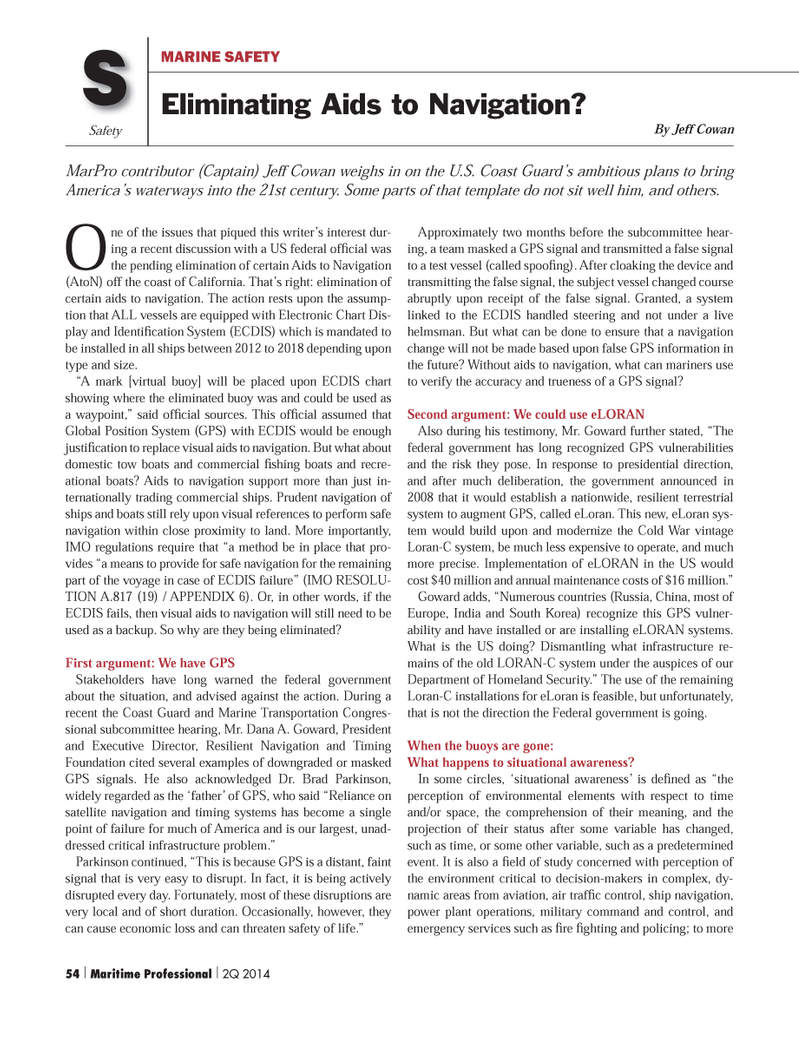
Page 54: of Maritime Logistics Professional Magazine (Q2 2014)
Maritime Risk & Shipping Finance
Read this page in Pdf, Flash or Html5 edition of Q2 2014 Maritime Logistics Professional Magazine
O ne of the issues that piqued this writer’s interest dur- ing a recent discussion with a US federal offi cial was the pending elimination of certain Aids to Navigation (AtoN) off the coast of California. That’s right: elimination of certain aids to navigation. The action rests upon the assump- tion that ALL vessels are equipped with Electronic Chart Dis- play and Identifi cation System (ECDIS) which is mandated to be installed in all ships between 2012 to 2018 depending upon type and size. “A mark [virtual buoy] will be placed upon ECDIS chart showing where the eliminated buoy was and could be used as a waypoint,” said offi cial sources. This offi cial assumed that
Global Position System (GPS) with ECDIS would be enough justifi cation to replace visual aids to navigation. But what about domestic tow boats and commercial fi shing boats and recre- ational boats? Aids to navigation support more than just in- ternationally trading commercial ships. Prudent navigation of ships and boats still rely upon visual references to perform safe navigation within close proximity to land. More importantly,
IMO regulations require that “a method be in place that pro- vides “a means to provide for safe navigation for the remaining part of the voyage in case of ECDIS failure” (IMO RESOLU-
TION A.817 (19) / APPENDIX 6). Or, in other words, if the
ECDIS fails, then visual aids to navigation will still need to be used as a backup. So why are they being eliminated?
First argument: We have GPS
Stakeholders have long warned the federal government about the situation, and advised against the action. During a recent the Coast Guard and Marine Transportation Congres- sional subcommittee hearing, Mr. Dana A. Goward, President and Executive Director, Resilient Navigation and Timing
Foundation cited several examples of downgraded or masked
GPS signals. He also acknowledged Dr. Brad Parkinson, widely regarded as the ‘father’ of GPS, who said “Reliance on satellite navigation and timing systems has become a single point of failure for much of America and is our largest, unad- dressed critical infrastructure problem.”
Parkinson continued, “This is because GPS is a distant, faint signal that is very easy to disrupt. In fact, it is being actively disrupted every day. Fortunately, most of these disruptions are very local and of short duration. Occasionally, however, they can cause economic loss and can threaten safety of life.”
Approximately two months before the subcommittee hear- ing, a team masked a GPS signal and transmitted a false signal to a test vessel (called spoofi ng). After cloaking the device and transmitting the false signal, the subject vessel changed course abruptly upon receipt of the false signal. Granted, a system linked to the ECDIS handled steering and not under a live helmsman. But what can be done to ensure that a navigation change will not be made based upon false GPS information in the future? Without aids to navigation, what can mariners use to verify the accuracy and trueness of a GPS signal?
Second argument: We could use eLORAN
Also during his testimony, Mr. Goward further stated, “The federal government has long recognized GPS vulnerabilities and the risk they pose. In response to presidential direction, and after much deliberation, the government announced in 2008 that it would establish a nationwide, resilient terrestrial system to augment GPS, called eLoran. This new, eLoran sys- tem would build upon and modernize the Cold War vintage
Loran-C system, be much less expensive to operate, and much more precise. Implementation of eLORAN in the US would cost $40 million and annual maintenance costs of $16 million.”
Goward adds, “Numerous countries (Russia, China, most of
Europe, India and South Korea) recognize this GPS vulner- ability and have installed or are installing eLORAN systems.
What is the US doing? Dismantling what infrastructure re- mains of the old LORAN-C system under the auspices of our
Department of Homeland Security.” The use of the remaining
Loran-C installations for eLoran is feasible, but unfortunately, that is not the direction the Federal government is going.
When the buoys are gone:
What happens to situational awareness?
In some circles, ‘situational awareness’ is defi ned as “the perception of environmental elements with respect to time and/or space, the comprehension of their meaning, and the projection of their status after some variable has changed, such as time, or some other variable, such as a predetermined event. It is also a fi eld of study concerned with perception of the environment critical to decision-makers in complex, dy- namic areas from aviation, air traffi c control, ship navigation, power plant operations, military command and control, and emergency services such as fi re fi ghting and policing; to more
Safety
MARINE SAFETY
Eliminating Aids to Navigation?
S
By Jeff Cowan
MarPro contributor (Captain) Jeff Cowan weighs in on the U.S. Coast Guard’s ambitious plans to bring
America’s waterways into the 21st century. Some parts of that template do not sit well him, and others. 54 | Maritime Professional | 2Q 2014 50-63 Q2 MP2014.indd 54 5/16/2014 3:01:23 PM

 53
53

 55
55
